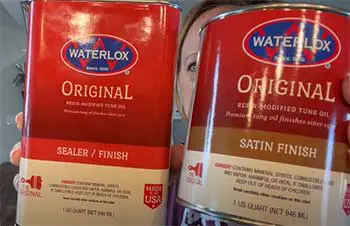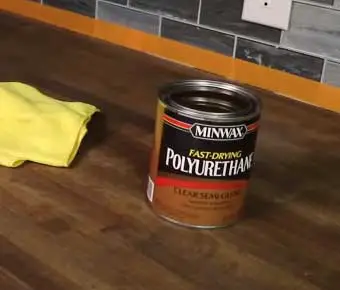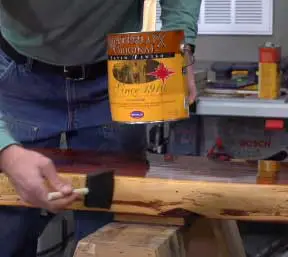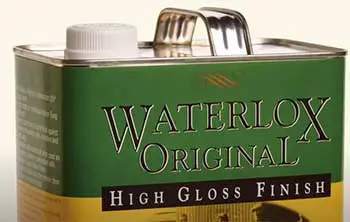Are you planning to build a new butcher block or repair an old one?
Then you should find the proper sealant. In that case, read my Waterlox vs. Polyurethane butcher block review to find the proper sealant for you.
These are popular sealants for wooden surfaces, including butcher blocks. But you have to know their features and comparisons to determine which one will work best for you.
A Quick Comparison Table
Here’s a quick comparison table between Waterlox and Polyurethane butcher blocks:
| Aspects | Waterlox | Polyurethane |
| Sealant Type | Resin-Modified Tung Oil | A Liquid Coating |
| Special Feature | Protective Yet Elastic Film | Non-Toxic When Dry |
| Benefits | More Benefits Than Polyurethane | Fewer Benefits Than Waterlox |
| Usage | Various Wooden Surface | Various Wooden Surface |
| Performance | High Performing | Similar Performance |
| Price | Cheaper Than Polyurethane | Slightly Expensive |
In-depth Differences Between Waterlox And Polyurethane Butcher Block
The above comparison table has given you some basic ideas. Now let’s dive into more details. Here, I will give you a comprehensive comparison between Waterlox and Polyurethane sealants.
So, let’s get started.
- Sealant Type

Waterlox is a resin-modified Tung Oil sealant that can penetrate deep into the wood to lock out water.
After applying this sealant to your butcher block, you will get a rich and distinctive finish and excellent sealing.
Besides, it is pretty easy to maintain.
On the other hand, Polyurethane is a crystal clear sealing formula that provides a rock-hard finish on the butcher block and other wooden surfaces. It comes as a liquid coating and becomes a plastic film when it dries.
With a layer of plastic, you will get excellent sealing against water and any other material that can harm your wooden surfaces.
- Features
Both Waterlox and Polyurethane are made to create a seal on wooden surfaces. But they are made differently. Thus you will find many differences in their features.
Waterlox is a very old formula that originated in 1910. It is probably the oldest wood sealing formula you can purchase today. However, 90% of the resin portion in the formula comes from natural and renewable sources.
Applying it on your butcher block or any wood surface will penetrate deep into the wood fiber and create a waterproof barrier.
Interestingly, it creates a protective yet elastic film that will last longer. This old formula is still handcrafted in small batches.
On the contrary, you will get a protective finish and an ambering effect on your butcher block after applying Polyurethane. This sealant becomes completely non-toxic when it dries and fully cures.
Besides, you can also use it over oil paint and stain. This rock-hard wood sealant is easy to apply, maintain, and restore.
- Benefits
You can reap many benefits from Waterlox and Polyurethane sealants. But before that, you have to know what benefits they bear.
Compared to other sealants, Waterlox is a clear interior or surface finish and sealant that is easier to maintain.
It becomes completely non-toxic after use; you never have to worry about contaminating your food.

Besides, you will get excellent adhesion to oily, dense, exotic wood like teak, rosewood, and Ipe from this sealant.
So, you can easily make your butcher block with these woods.
Apart from that, the sealant will enhance the wood grain and bring out its inherent beauty.
In contrast to Waterlox, Polyurethane will never turn yellow over time. It offers excellent performance on lighter wood like maple and neutral satin colors like black, gray, and white. On top of that, you won’t have to make them thin before use.
- Other Usage
You can use both sealants on your butcher block. Now let’s look at other places where you can use these sealants. It will help you understand which one will be best fitted for you.
You can use Waterlox on various interior wood surfaces, including floors, windows, doors, cabinetry, woodwork, tables, furniture, bar tops, picture frames, etc. Apart from these, you can use it on various other woodworking projects.
Similarly, Polyurethane also works perfectly fine with various interior and exterior wood surfaces. Some are doors, floors, windows, tables, furniture, cabinetry, woodwork, bar tops, picture frames, and many other woodworking projects.
So, we found that both sealants work on the same surfaces. You can’t differentiate between them based on this factor.
- Performance
You can seal up to 125 square feet of a wooden surface per coat with one quart of Waterlox sealant. Plus, it will take a minimum of 24 hours to dry, and after that, you can recoat again.
On the other hand, you can recoat Polyurethane sealant within 6 to 12 hours, as it will take only this much time to dry. One quart of Polyurethane will cover up to 125 square feet.
- Available Sheen
The number of available sheens is essential. Because it determines what your surface will look like after applying the sealant.
Both Waterlox and Polyurethane offer the same number of sheens. You can choose between Gloss, Semi-Gloss, and Satin sheen for sealing your butcher block. So, no differences here either.
- Price
Price can be an essential differential factor for both sealants. It can motivate customers to choose one specific product. One quart of Waterlox sealant can cost around $47.99. In contrast to that, one quart of Polyurethane costs around $50.
So, we can see, Polyurethane is slightly more expensive than Waterlox sealant.
Analyzing The Pros And Cons Of Waterlox For Butcher Block
Waterlox is a highly regarded penetrating tung oil-based sealer and finish specifically designed for wood surfaces like butcher blocks. It has been used by woodworkers for over 100 years to finish all types of furniture, cabinetry, and wood surfaces while enhancing their natural beauty.
Here are some of the main benefits and potential drawbacks of using Waterlox on a butcher block countertop:
Pros

- Deeply penetrates wood for moisture, scratch, and stain resistance
- Forms a flexible, protective barrier that expands and contracts with wood
- Easy to apply with a brush, levels smoothly
- Dries fast enough for 2-3 coats in a day
- Resists heat up to 180°F once fully cured
- Does not darken or change color of wood
- Allows wood to age naturally over time
- No sanding or stripping needed for touch ups
- Non-toxic when cured, safe for food prep surfaces
Cons
- Requires 2-3 thin coats for proper moisture barrier
- Full cure time is 3 days
- Not quite as hard and scratch-resistant as some polyurethanes
- Higher cost than many water-based polys
Overall, Waterlox offers the perfect balance of protecting, enhancing and maintaining the wood’s natural patina in a butcher block countertop while allowing for easy renewal and touch ups as needed over time.
Those desiring maximum scratch protection may favor a polyurethane, but sacrifice some of that warm, organic life quality you want from a real wood countertop.
Examining the Characteristics of Polyurethane for Butcher Block
Polyurethane is a protective plastic resin used in everything from wood floor finishes to paints and varnishes. When used as a sealant for butcher block countertops, polyurethane provides a clear, durable moisture barrier that also resists heat, stains, and minor surface damage:
Pros
- Very durable protective finish
- Excellent moisture, heat, and stain resistance
- Comes in various sheens from satin to gloss
- Typically lower cost than oils like Waterlox
- Some newer water-based polys are low VOC
- Many are food safe once fully cured
Cons
- Susceptible to scratching, gouging over time
- Can chip away along edges and seams
- Needs 3-5 thin coats for proper protection
- Longer full cure times – up to 2 weeks
- Solvent-based types have strong fumes
- Must fully sand and refinish for touch ups
Compared to Waterlox, polyurethane brings slightly better overall protection from surface damage, moisture, and stains. But over decades of use on a butcher block countertop seeing daily action, Waterlox holds up better aesthetically as it allows the wood to age naturally without chipping or peeling.
For an extremely durable surface with less concern over long term patina, a polyurethane finish makes an outstanding shield that stands up to heavy use. It just depends whether protection or preserving the organic essence of the wood matters most for your countertop needs and personal style.
Which Sealant Is Best For You?

After the detailed discussion on the sealant, it’s time to decide which one is best for you, Waterlox or Polyurethane.
I think it is clear that Waterlox is the best option for butcher blocks and any other wood surfaces.
Because Polyurethane creates a plastic film over your wooden surface, there will always be a barrier between you and your wooden surface.
Plus, the plastic film might wear off after heavy chopping and other usages.
On the contrary, Waterlox penetrates the wood and remains there while sealing wood surfaces from water. On top of that, it is less expensive and will enhance your butcher block surface color.
Frequently Asked Questions (FAQ)
Yes, Waterlox is better than Polyurethane. It penetrates the wood and creates an elastic and protective finish to lock water and will not chip or peel out. You also enhance the color of wood surfaces with Waterlox.
Waterlox is the staple for finishing butcher block countertops. With a unique formula of resins, you will get excellent longevity and easy maintenance.
Mineral oil is being used traditionally for finishing butcher block countertops. That’s why products like Waterlox with mineral oil and resins have been used for a long time.
Polyurethane is one of the sealants used for waterproofing wooden surfaces. So, yes, you can use it on your butcher block countertops.
Final Thoughts
As I said previously, you will have a clear idea about both products after going through my Waterlox vs. Polyurethane butcher block review. Now we are at the end of it, and you have a clear choice in front of you.
To top it off, I suggest you use the sealant I pointed you out. You’ll be glad that you did.

Ralph, I made a 76×39 inch quarter sawn walnut butcher countertop for an Island. The quarter sawn strips are 2×2 inch. I don’t plan to use it for cutting purposes but simply something similar to a table use. The last large oak harvest table I made, I finished it with several coats of polyurethane and it lasted for 26 years without needing a refinish. That was used by a family of 6. I am, however, seriously thinking about trying waterlox for this quarter sawn large walnut butcher block counter top. The other product that I am considering is Minwax’s most durable and fast drying polyurethane.
I am still up in the air about which way to go. I want it to look nice, be scratch resistant, water resistant, and be food safe, but I don’t want constant maintenance. Could go either way? Both products seem to be very good based on your analysis, although it appears you like the Waterlox. Any further enlightenment that could tip the scale? Thanks. Lawrence